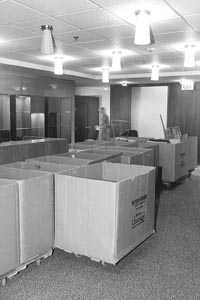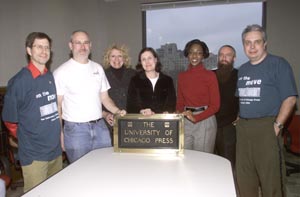University Press moves to its new home
It would be easy for a visitor to imagine that the new University Press headquarters at 1427 E. 60th St. has long been a part of the Midway. Peering out over the tree line from any one of the building’s north-facing third-floor windows–with Albin Polasek’s monumental sculpture of Thomas Masaryk set in profile against a winter sky and the sun-lit limestone edifice of University buildings receding westward along 59th Street–one can see a historic view that reinforces the Press’s connections to campus.
 Paula Barker Duffy, Director of the University Press, unpacks boxes of books in her office in the new University Press Building, 1427 E. 60th St. The Press staff moved from its offices in the Administration Building on Ellis Avenue to the new building, designed to accommodate the needs of the Press staff. Once they are settled into their new home, the Press Journals and Books Divisions will be housed at the same location for the first time in 25 years. Duffy said the move will be beneficial to both divisions as they continue to explore the possibilities of electronic publishing. |
Despite their busy production schedule for 2001, nearly 240 of the Press’s staff members have spent the first weeks of January packing books, files and personal belongings into cardboard cartons to prepare for the move into their new home. Once the process is complete, the Press’s Journals and Books Divisions will be housed at the same location for the first time in more than 25 years.
Paula Barker Duffy, Director of the University Press, said she anticipates that the move will be enormously beneficial to the organization. “Particularly as both Books and Journals delve deeper into the possibilities of electronic publishing, staff members of the two divisions have so much to learn from working together,” she commented.
The new building by architects Booth Hansen Associates provides staff members with a more open, communal workspace in which to do so. Its high-speed Ethernet connections and state-of-the-art workstations reflect the organization’s commitment to engage with the technological innovations that continue to transform the world of scholarly publishing.
“I think we’ve managed to build in a very robust versatility,” said Duffy. “Board rooms, training facilities and common working areas will allow us to be more flexible with things like departmental meetings that draw on both divisions.”
Duffy pointed out that the space also provides for new administrative offices that will improve working lives of all members of the Press staff. “This will be the first year that the Books Division will have on-site access to our Manager of Human Resources, Onshelle Jackson,” she explained. “Her knowledge of hiring and employment issues has already been incredibly important for the Journals Division. Now all of us will be able to benefit from her work.”
Long before plans for the neo-Gothic structure came to fruition over the past year, Press operations had grown to occupy five sites citywide. While the Books Division has been centrally located in Administration office space since 1969, the Journals Division has spread out across Hyde Park to take up three separate locations. The Press warehouse facility and distribution center, which will remain separate from the organization’s campus operations, has been located in the Pullman district on Chicago’s far South Side since 1965.
By the mid-1990s, with its different operational wings already far dispersed, proposals for new ventures with many of the Press’s journals meant that further expansion would soon be needed. “Rather than settle for another temporary solution to our space needs, the University commissioned a new building,” explained Penelope Kaiserlian, Associate Director at the Press. She credits Geoffrey Stone, Provost of the University, and Patricia Woodworth, Vice President and Chief Financial Officer, for their involvement in the efforts to realize the project.
  Boxes of books and other office essentials for members of the Press sit in the lobby area after movers worked for days bringing them from Ellis Avenue to 60th Street. They may have new offices and work stations at their new location on 60th street, but an old plaque also identifies this group and other staff members who occupy that new site–The University of Chicago Press. Members who took a moment to pose for a photo are (left to right) Erik Carlson, Perry Cartwright, Sue Ormuz, Paula Barker Duffy, Onshelle Jackson, Douglas Mitchell and Mike Brehm. |
According to Robert Shirrell, Manager of the Journals Division, the Press’s current period of growth began in 1992 when Journals began working in partnership with the American Astronomical Society–sponsored by the National Science Foundation–to investigate possibilities for an electronic prototype journal. “That publication, the Letters section of The Astrophysical Journal, went online in 1995,” recalled Shirrell. “With the January 1997 issues, we began to publish online the entire text of The Astrophysical Journal, approximately 25,000 printed pages per year of complex text, mathematics, figures and tables.”
Since that time, the Journals Division has begun full-scale electronic publication of 11 other journals in the biological, medical and physical sciences, and has recently launched new online editions of six other journals in the social sciences. These and other initiatives in Web-based publishing have required that the Press hire and train dozens of new employees with the expertise to realize its goals for the new medium. Much of the interior workspace of the new building was specially designed to facilitate their role as emergent media spur the Press’s continuing evolution.
According to Kaiserlian, the Books Division also has recently entered the age of online publications with two major electronic editions. “The first, available online since the spring of 2000, is a Web-based edition of The Founder’s Constitution, a five-volume collection edited by Philip B. Kurland and Ralph Lerner, which the Press published in 1987,” she explained. “The Chicago Homer, our first Web-based publication without an existing print edition, will become available in 2001.”
While the reunion of the two divisions and the technical advantages of the new facilities provide cause for celebration, the move itself has presented an enormous logistical challenge. Cold weather, snow and ice have made the project even more difficult. Boyer-Rosene, the moving company contracted by the Press, estimated that it moved more than 2,100 cartons, hundreds of pallets, in 50 truck loads over four days.
Although the new building will not officially open for a few more months, one final feature of the new location may make some of the headaches associated with the transition worth their while: a book-lined cafÈ with wide, arched windows will grace the east wing of the building’s first floor.
Duffy, who was actively involved with plans for the cafÈ, said she has faith that the space will become a favored lunch-spot for book lovers from around the campus. “We hope to have readings by Press authors that will be open to everyone,” she said. “It’s just one of the ways we’ll be able to bring a new sense of literary excitement to the campus community.”
Early in February, the Press will issue a newsletter, Bookmark, which will include further details about the organization and where it is headed. Also, the Press plans an open house during the afternoon on Tuesday, March 6, for those curious about the new building.
![[Chronicle]](/images/small-header.gif)